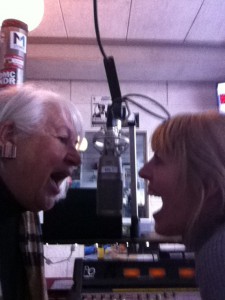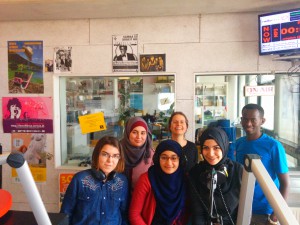Nachdem die Regierung noch geringfügige Änderungen vorgenommen hat, soll am 25. Feburar das Islamgesetz in Kraft treten. Die Regierung hat beschlossen, dass Funktionsträger aus dem Ausland ihre Funktion nur noch bis zu einem Jahr nach der Verabschiedung des Gesetzes weiter ausüben dürfen.Viele Vertreter der Glaubensgemeinschaft sind mit dieser Änderung nicht einverstanden. Außerdem werden auch der rechtliche Status der Organisationen und Moscheevereinen, Ansprüche auf Seelsorge beim Bundesheer, in Strafanstalten und Krankenhäusern, sowie ein eigenes Theologiestudium, gesetzliche Feiertage und Lebensmittelbestimmungen im Islamgesetz geregelt.
Anlässlich dazu wird es am Dienstag beim Magazin um 5 ein Studiogespräch mit Peppo Mautner (Plattform für Menschenrechte), Farid Hafez (Politikwissenschaftler) und Anisa Halilovic (Muslimische Jugend) zum Thema Islamgesetz geben.
Archiv der Kategorie: Uncategorized
Sebastian Link zu Gast: Vom Ausbrechen und Sich-Treiben-Lassen
 Eine schwere Krankheit im zarten Alter von 20 Jahren nahm er als Chance, um Aufzuwachen. Er riss alle Brücken hinter sich ab und zog hinaus in die Welt, um am Ende mehr bei sich selbst anzukommen. Ein Leben zwischen Pferdekarawane in Spanien und der Arbeit als DJ auf Festivals in ganz Europa. Nun ist er zu seinen Wurzeln in Salzburg zurückgekehrt und gibt in der eigenen Gesundheitspraxis etwas von seiner Erfahrung weiter.
Eine schwere Krankheit im zarten Alter von 20 Jahren nahm er als Chance, um Aufzuwachen. Er riss alle Brücken hinter sich ab und zog hinaus in die Welt, um am Ende mehr bei sich selbst anzukommen. Ein Leben zwischen Pferdekarawane in Spanien und der Arbeit als DJ auf Festivals in ganz Europa. Nun ist er zu seinen Wurzeln in Salzburg zurückgekehrt und gibt in der eigenen Gesundheitspraxis etwas von seiner Erfahrung weiter.
Wer bin ich wirklich?
Wo zwänge ich mich in gesellschaftliche Vorstellungen, die mir nicht entsprechen?
Eine gute Portion Mut, um sich selbst zu hinterfragen. Ein Schritt zu einem erfüllteren Leben.
Und dann: einfach mal L_O_S_L_A_S_S_E_N________________________________________________________
[iframe src=“http://cba.fro.at/281422/embed?&waveform=false&socialmedia=true&subscribe=true&series_link=true“ width=“100%“ height=“148″ style=“border:none; width:100%; height:148px;“]
Infoabend Radio Reichenhall am Mi, 25. Februar um 18:30 Uhr
Am Mittwoch, den 25. Februar 2015 um 18:30 Uhr findet der vierte Infoabend zum
“1. deutschen Außenstudio der Radiofabrik” in Reichenhall statt.
Auch diesmal treffen wir uns im Café Harlekin im “Gelben Haus” Ecke Tiroler/Anton-Winkler-Straße. Lageplan – ANZEIGEN
Für Infos und Fragen bitte an Eva Schmidhuber wenden: +43-662-84 29 61-24, e.schmidhuber@radiofabrik.at
„Geile Gedichte“ – Erotische Poesie im Kleinen Theater
Erotische Poesie wird heute der Themenschwerpunkt beim „Magazin um 5“ sein, dabei begrüßen wir die Schauspielerin Susanne Czepl live bei uns im Studio. Dass es Erotik nicht erst seit 50 Shades of Grey gibt, beweist das Theaterstück „Geile Gedichte“, in dem Susanne Czepl die Hauptrolle spielt. Das Stück beschäftigt sich mit erotischer Poesie der letzten 300 Jahre , denn schon Goethe, Brecht, Rilke und Co. haben ihre Feuchtträume in Worte gepackt. Untermalt mit Musik wird am Donnerstag den 19. Februar 2015 die Premiere im kleinen Theater stattfinden.
Weitere Themen: Erinnerungspolitik in Rumänien / offener Brief der Plattform für Menschenrechte an Bürgermeister Heinz Schaden
Google und das Fernsehprogramm
Google und das Fernsehprogramm
Was haben Google und das Fernsehprogramm mit Hunden zu tun? Nun, in den letzten Jahren hat der Einfluss des Internets auf unser Leben stetig zugenommen und macht auch vor der Hundehaltung nicht stop. Und auch die Fernsehstationen scheinen auf den Hund gekommen zu sein. Schäferhund im Polizeidienst war gestern! Heute gibt es Fellnasen, die Castingshows gewinnen, Ratespiele mit Semiprominenten und ihren Hunden und vor allem jede Menge Erziehungsratgeber – Suppernanny für Asta, Finn und Kimberly!?
Wie nützlich sind die Informationen, die wir auf diesem Wege erhalten? Bergen die neuen Medien auch Gefahren und welche sind das. Das sind einige der Fragen, die wir in der Hunderunde am 11. Mai besprechen. Wir, das sind in dieser Sendung Barbara „Sunny“ Benett und Corinne Kaelin.
Sunny Benett ist Trainerin in Wien, www.dogsinthecity.at, Bloggerin und Pressesprecherin der Vereinigung Öst. HundeverhaltenstrainerInnen. Für ihre wissenschaftliche Abschlussarbeit für den ULG Angewandte Kynologie „Erfassung und Prävention der von televisiertem Hundetraining ausgehenden Gefahren und die praktische Umsetzung der Erkenntnisse durch gezielte Aufklärungsarbeit“ erhielt sie im vergangenen Jahr den Öst. Bundestierschutzpreis und verschaffte damit zugleich modernen und gewaltfreien Erziehungsmethoden einen gewaltigen Öffentlichkeitsauftritt.
Für diese Arbeit wurde unter anderem eine Episode einer bekannten TV-Sendung analysiert und auf ihr Gefahrenpotential hin untersucht. Auch auf der Petexpo 2014 konnte Sunny Benett die Ergebnisse ihrer Arbeit im Rahmen eines Vortrags präsentieren:
Corinne Kaelin war in der Schweiz als Trainerin eifrige Seminarbesucherin und suchte nach ihrer Übersiedlung in die USA nach Möglichkeiten, weiterhin mit den ihr bekannten und von ihr geschätzten TrainerInnen aus Europa in Verbindung bleiben zu können. So entstand im Jahr 2011 die dog-ibox. Inzwischen ist dog-ibox ein international renommierter Anbieter von Trainerfortbildung via Internet. Zu den Referentinnen gehören neben verschiedenen Vortragenden aus den USA nach wie vor viele bekannte TrainerInnen aus Deutschland, Österreich und der Schweiz.
Ich habe über Facebook und im know wau – Newsletter zur Teilnahme an einer kleinen Umfrage eingeladen. Darin ging es darum, woher wir unser Wissen über Hunde(erziehung) beziehen. Wer es genauer wissen möchte. Hier geht’s zur Umfrage Umfrage Hundewissen 2015 und hier zu dem Ergebnissen Umfrage Hundewissen 2015 – Google Formulare.
Servicebox:
Bundestierschutzpreis für Sunny Benett:
Folder: TV-Training kritisch betrachtet
TrainerInnennetzwerke:
www.voeht.at
www.cumcane.de
www.trainieren-statt-dominieren.de
www.gewaltfreies-hundetraining.ch
Informative Hundeseiten:
www.spass-mit-hund.de
www.easy-dogs.net
www.markertraining.de
Die Musik zur Sendung:
Montserrat Caballe und Freddy Mercury – How can I go on
Claudia Koreck und Hubert von Goisern – Weit, weit weg
Joaquin Phoenix und Reese Witherspoon – Time’s a wastin‘
Sendung anhören:
Live auf der Radiofabrik 107,5 oder per Livestream immer am 2. Mittwoch im Monat um 12:08 Uhr und am 2. Donnerstag im Monat um 19:06 Uhr. Nachhören ebenfalls über die Radiofabrik oder über den Hunderunde Blog.
Feedback und Kontakt: Karin Immler, www.knowwau.com
Hundewissen zum Hören im Hundepodcast von know wau.
„Entweder-Oder“ – Ein Hörtheater über Diskriminierung im Arbeitsmarktzugang
Redaktion: Elisabeth Rieser und Martha Schweissgut
Schnitt und Technik: Abdisalan Ali und Martha Schweissgut
[iframe src=“http://cba.fro.at/280362/embed?&socialmedia=true&subscribe=true&waveform=false&series_link=true“ width=“100%“ height=“148″ style=“border:none; width:100%; height:148px;“]
Hundeerziehung im Zeichen von Facebook, Google und TV
Das Facebook, Google und überhaupt das Internet haben unser Leben umgekrempelt. Kaum jemand, der dieses neue Medium nicht nutzt. Und das Fernsehen ist ohnehin schon lange ein wesentlicher Teil unseres Lebens. Man schaue sich nur einmal die Ausstattungsvorschläge der Möbelhäuser an, dann wird rasch klar, was für einen Stellenwert „des Kastl“ hat.
Doch was bedeutet das für Hundehalterinnen? Haben wir heute mehr und womöglich hochwertige Information jederzeit abrufbar zu unserer Verfügung? Oder ist es Schund und Schrott, was uns da ins Haus geliefert wird? Und kann ich als UserIn oder FernsehzuseherIn die Spreu vom Weizen trennen?
Sunny Benett, die für Ihre Arbeit zum Thema TV-Hundeerziehung den Bundestierschutzpreis 2014 bekommen hat, ist in dieser Sendung zu Gast und wird über ihre Sicht der Dinge berichten.
Fortbildung und Weiterbildung mittels Internet ist ebenfalls längst keine futuristische Vorstellung mehr. Webinare und Teamtraining werden zu unterschiedlichsten Themen angeboten: von Serviettentechnik bis zum Sprachkurs. Von der Bedienung spezieller Programme und Geräte bis zum Brainstorming ist ohne großen Aufwand alles online möglich. Bequem in Patschen von zuhause aus lernen, noch dazu über Hunde und Hundeerziehung.
Auskunft darüber kann Corinne Kaelin von dog-ibox.com geben , die verstärkt Webinare über Hundehaltung und Hundeerziehung anbietet und einen wachsenden Zuspruch zu verzeichnen hat.
Außerdem habe ich eine kleine Umfrage gestartet, woher wir unsere Informationen zu Hundefragen beziehen, und ein paar interessante Antworten bekommen.
Sendung anhören:
Live auf der Radiofabrik 107,5 oder per Livestream immer am 2. Mittwoch im Monat um 12:08 Uhr und am 2. Donnerstag im Monat um 19:06 Uhr. Nachhören ebenfalls über die Radiofabrik oder über den Hunderunde Blog.
Feedback und Kontak: Karin Immler, www.knowwau.com
Hundewissen zum Hören im Hundepodcast von know wau.
Magazin um 5: Wiedereröffnung der Notschlafstelle „Arche Süd“
Die Notschlafstellen der Stadt Salzburg reichen für diesen Winter nicht aus, seit vergangenen Sonntag ist daher die „Arche Süd“, das Notquartier in der Pfarre Herrnau wieder geöffnet. Das ist allerdings nur möglich durch die Mitarbeit von über 50 Freiwilligen, denn leider habe „Barmherzigkeit finanzielle Grenzen“, so Caritas Direktor Johannes Dines. Die Arche Süd wurde eigentlich immer nur als temporäre Übergangslösung geöffnet, wie die Situation nun aussieht, wie lange das Quartier verfügbar sein wird und auch, warum derzeit ein so hoher Bedarf an Notquartieren besteht, darüber haben spricht Edda Böhm von der Caritas am 3. Februar 2015 im Magazin um 5.
Weitere Themen: Aus für Demokratiemodell in Salzburg / Hintergründe des Freihandelsabkommen TISA / Greenpeace-Aktion gegen Umweltverschmutzung durch Plastiksackerl
5jähriges Jubiläum im Toihaus: BIMBAM – Internationales Theaterfestival für Kinder
Seit 2007 findet alle 2 Jahre das BIMBAM Festival statt, das internationale Theaterfestival für Kinder. Heuer ist es wieder so weit, in nicht mal mehr 3 Wochen geht es wieder los mit einem ganzen Festival nur für Kinder. Geboten werden Stücke aus ganz Europa, gespielt wird an diversen Spielstätten in Salzburg. Von einfachen Requisiten wie Holz, Papier oder Steine bis hin zu aufwendigen, dreidimensionalen Bühnenbildern ist auch diesmal wieder alles dabei. Ihr hört heute alles zum BIMBAM und zum Programm in den nächsten Wochen und auch schon einzelne Ausschnitte aus den Stücken.
Und während die kleinen Theaterbesucher ab 21. Februar im Toihaus und an anderen Lokalitäten in Salzburg voll auf ihre Kosten kommen, gibt es natürlich auch für Erwachsene wieder mal etwas sehr „toiartiges“. Arturas Valudskis ist momentan wieder im Toihaus zu Gast und er steht mit seinen Werken immer für skurriles, tragisch-komisches und für starke Inszenierungen. Mit „Das Leben im Wandschrank“ adaptiert er diesmal den spanischen Klassiker „Bernada Albas Haus“ von Garcia Lorca. Alle Infos zum Stück und auch einen Auschnitt daraus gibts in der aktuellen Ausgabe von So A Theater zu hören.
Mag. Cordula Hofmann-Molis live: von einem eisernern Willen und dem Aufeinanderprall dreier Welten
 Sie ist eine starke Frau, die man nicht so schnell vergisst. „DAS WILL ICH“ hat sie hinausgerufen in die Welt, und viele ihrer Träume hart erarbeitet und erreicht.
Sie ist eine starke Frau, die man nicht so schnell vergisst. „DAS WILL ICH“ hat sie hinausgerufen in die Welt, und viele ihrer Träume hart erarbeitet und erreicht.
Kostümbildnerin in der schillernden Welt von Theater und Oper, 5 Jahre Schafbäurin ganz in den Vibes der 1970er und 35 Unterrichtsjahre an der Universität Mozarteum in Salzburg. Und ganz nebenbei hat sie noch eine Familie gegründet – mit der großen Liebe ihres Lebens.
Wo ein Wille ist, da ist ein Weg!

 Sonntag, 1. Februar 2015, 15:00 – 16:00
Sonntag, 1. Februar 2015, 15:00 – 16:00
Live in der Radiofabrik!
[iframe src=“http://cba.fro.at/279208/embed?&waveform=false&socialmedia=true&subscribe=true&series_link=true“ width=“100%“ height=“148″ style=“border:none; width:100%; height:148px;“]


